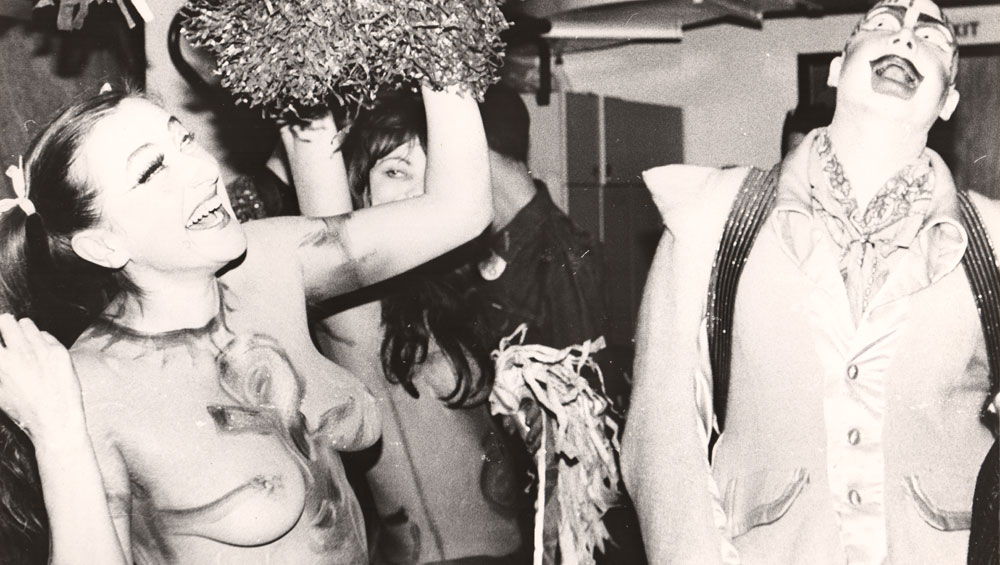
Neo Naturist Cheer Leaders with Leigh Bowery and Michael Clark, Royal Opera House, London, 9 February 1986. Courtesy of the Neo Naturists Archive.
Studio Voltaire, London
8 July – 28 August 2016
by CASSIE DAVIES
Studio Voltaire has brought together an exuberant selection of archival materials in celebration of the performance art group, the Neo Naturists. The group, founded by Christine Binnie, Jennifer Binnie and Wilma Johnson, came together in the early 1980s during a period of rapid political and social change in the UK: punk had reached its aftermath, and Thatcherism had arrived. On the backdrop of this emerged a subculture, ripe in creative energy, one which positioned itself away from mainstream culture and into a subversive network of cultural figures, collaborators and communities. It was in this space that the Neo Naturists took their performances, using their nude bodies and paint to explore body image and identity.
Set up in the main gallery of Studio Voltaire are projectors and television screens, glass cabinets filled with posters, book forms, cassette tapes, newspaper cuttings and diary pages. A prop list from 1981, written by one of the Neo Naturists, reads: “Prawns + Crabs + other fish / Herrings? Gutting?” This eclectic array of items documents the Neo Naturists’ performances in the 80s. But the show goes beyond documentation; Studio Voltaire gives its audience the chance to experience – almost first-hand – the practice of the Neo Naturists. The main gallery space is transported to a different era: 80s pop music, singing, shouts and laughter fill the room; multicoloured body prints line the walls, between which still images reel from projectors, and video footage plays on TV screens. The Neo Naturists’ performances and actions were never rehearsed, and the show at Studio Voltaire indulges itself in their spontaneity. There is little to no guidance in the show. Instead, the viewer is given free rein to move between the selection of material presented to them.
Nudity is everywhere in the gallery space. At the basis of the group’s performances are their bodies, stripped of clothing and decorated with body paint. Christine Binnie and Johnson first began experimenting with body painting at St Martin’s School of Art, believing that body art had a radical potential. Their nude, painted bodies were reactions against the political and social climate that surrounded them. They were disaffected by the Thatcherism of the early 80s, which had produced an ideal of the female body that was perfectly kempt, refined and fit. In an art world overtaken by masculine neo-expressionism, performance art had no place. In the new romantic club scene, where the Neo Naturists began performing, excess and costume was only encouraged among cross-dressing males.
Their image of female nudity was unerotic. Instead, they distanced themselves from the sexualised ideal of the nude feminine and sought “family values”, writes Louisa Buck in her essay accompanying the show. Christine and Wilma explored different styles of painting, covering their bodies with bloated faces, handprints and trompe l’oeil clothing. Their activities overlapped with Jennifer Binnie and Grayson Perry, who were also exploring body painting at Portsmouth Polytechnic. In 1980, Christine set up a word-of-mouth cafe, The Coffee Spoon, in an abandoned Lewis Leathers shop. The cafe became a hub of creativity, with occasional cabaret evenings, poetry events, film screenings and, one night, a performance by Jennifer and Grayson Perry.
They took their public performances to festivals and nightclubs in London, such as the Blitz Club in Covent Garden, Le Beat Route in Soho and Dai Llewellyn’s club, Wedgies, in Kings Road, Chelsea. Eventually, as the art world broadened, they began performing at art galleries. One of their most notable performances was a week-long residency at David Dawson’s B2 Gallery in Wapping in July 1982, for which they enacted a different theme each day: Private View Day, Fashion Day, Macbeth Day, Punk Day and Black Rapport Day.On Black Rapport Day,the group painted themselves in black body paint and consumed only black food and drink. The Neo Naturists saw the liberating possibilities of ritual in performance, and they incorporated this in to their practice, often making references to the English pastoral and themes such as fertility cults, seasonal cycles, the circle of life and death. We see this in Autumn in Folkington (1981), a film by Jennifer, in which her body lies in woodland, covered in red body paint with patches of fire burning around her.
In 1983, Christine, Jennifer and Perry moved into a squat in Camden, and their activities became even more intertwined. They stayed there until 1986, a three-year period which saw the peak of their creative activities. The group tested their practice in other, more inappropriate public settings: projected on to the wall at Studio Voltaire is Flashing in the British Museum, London, 1982, a photograph of Christine opening her fur coat in the British Museum to reveal her naked body: eyes painted over her breasts, a nose pointing down to the red lips that stretch across her stomach. The photograph, taken by Wilma, captures one of the group’s first site-specific, unannounced performances. Another image, Swimming and Walking Experiment, 1984, shows the Binnie sisters and Wilma performing impromptu in the fountains at the foot of the Centre Point building in Tottenham Court Road, London. Somehow, the group managed to dodge arrest.
There were few, if any, obstacles to the Neo Naturists. Their performances weren’t always received well: their May Day Performance at Centro Iberico, a Spanish anarchist centre in Notting Hill, was badly received by the audience, who were displeased by their Communist-style uniforms and feigned political gestures. Later that night, they repeated the performance at the Fridge, a nightclub in Brixton, and the audience’s hostility led to them being removed from the stage by security during the performance. Hostility aside, the Neo Naturists flaunted their nudity with good-humour, seriousness, and without shame. Their radical gestures still hold prominence today: their performances and nudity celebrate the female body outside of a sexualised, objectified arena.